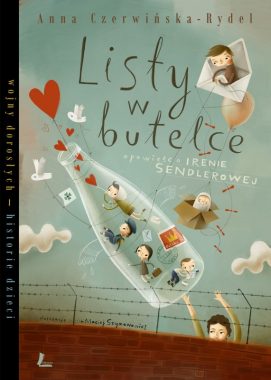Author: Anna Czerwińska-Rydel
Illustrator: Maciej Szymanowicz
Year: 2018
Publisher: Literatura
Place of publication: Łódź
Pages: 116
ISBN: 9788376725482
Notes: “Wojny dorosłych – historie dzieci” series
Translations:
- Lists in a Bottle: A Story about Irena Sendler, trans. Katarzyna Wasilkowska, Łódź: Literatura, 2018, pp. 120, ISBN: 9788376725758.

Although Renata Piątkowska’s All of My Mums was also inspired by Irena Sendler’s activities during wartime, Listy w butelce [Lists in a Bottle] is the first full biography of this famous social worker aimed specifically at the young reader. Anna Czerwińska-Rydel presents the life of her protagonist from the times of World War Two until the year 2007, when she was awarded children’s Order of the Smile. The eponymous lists or letters are a recurring theme of the book, connecting its parts. The title (with the Polish plural noun listy meaning both “letters” and “lists”) refers to the staging of Rabindranath Tagore’s play Post Office at Janusz Korczak’s Orphan Home as well as the lists of names of Jewish children (placed in glass milk bottle and buried in the ground) for whom Sendler organized “new lives” on the other side of the ghetto wall. Each chapter is preceded by a quotation on letter-writing, which anticipates the third part of the biography (entitled “Correspondence”), where real letters to and from Sendler are printed (including one by Pope John Paul II). “Jolanta’s” post-war story, filled with social work and education for employees of health institutions, is presented in brief. It ends in 2007 at Sendler’s decoration with the Order of the Smile.
Lists in a Bottle is a tale of a courageous woman who used all of her strength and risked her life in order to take a stance against the suffering of Holocaust victims. A series of scenes from the Ghetto reveals the realities of the Shoah and shows the help extended to Jews living in the Ghetto. Not only does Sendler think how to help the needy most effectively (by smuggling in food or medicine, and smuggling children out), but also acts on her thoughts, full of devotion to the people in need. Importantly, Czerwińska-Rydel depicts a spectrum of Jewish parents’ reactions to rescue plans: some refuse to give up their children out of fear or reluctance towards their necessary assumption of a new non-Jewish identity.
Bibliography:
- Baluch, A., Ludzie i przedmioty. Literatura dla dzieci jako szkoła estetycznej wrażliwości, „Paidia i Literatura”, no. 2, 2020, pp. 59–66 (p. 60);
- Rybak, K., Żyd i uchodźca. Znaczące powinowactwa narracyjne w polskiej literaturze dziecięcej ostatniej dekady, „Czy/tam/czy/tu. Literatura dziecięca i jej konteksty”, no. 2, 2017, pp. 44–62 (p. 59, fn. 9);
- Rybak, K., I (nie) żyli długo i szczęśliwie. Konstrukcje zakończeń w polskiej literaturze dziecięcej o Zagładzie, “Literatura Ludowa”, vol. 63, no. 1, 2019, pp. 10–23 (p. 10, 12);
- Rybak, K., Dzieciństwo w labiryncie getta. Recepcja mitu labiryntu w polskiej literaturze dziecięcej o Zagładzie, Warszawa 2019 (pp. 14–15, 65, 70, 88, 101, 106–107);
- Rybak, K., Stosunki polsko-żydowskie i Zagłada w polskiej literaturze dziecięcej XXI wieku, [in:] Stosunki polsko-żydowskie, vol. 2, Kultura. Literatura, sztuka i nauka w XX wieku, ed. Z. Trębacz, Warszawa 2020, pp. 171–187 (p. 174, fn. 7; 179);
- Rybak, K., Zagłada i ideologia w polskiej literaturze dziecięcej XXI wieku, „Narracje o Zagładzie”, no. 1(7), 2021, pp. 155–173 (p. 159, fn. 18);
- Rybak, K., „Zupełnie inne miasto”. Obrazy warszawskiego getta w polskiej literaturze dziecięcej XXI wieku, „Dzieciństwo. Literatura i Kultura”, no. 3(1), 2021, pp. 67–84 (p. 70, 72);
- Rybak, K., Obrazowanie Zagłady. Narracje holokaustowe w polskiej literaturze XXI wieku dla dzieci i młodzieży, Warszawa 2023.